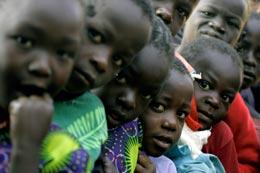Circumcision makes economic sense in fight against HIV
But too few men have access to the procedure, say advocates.
Circumcision not only saves lives by reducing the risk of HIV infection, it also has clear economic benefits, according to research presented at the 17th International AIDS Conference in Mexico City.
But advocates say that these benefits are not being realized due to controversies surrounding the procedure.
 Members of the Luo tribe have resisted circumcision programmes.AP PHOTO/J. DELAY
Members of the Luo tribe have resisted circumcision programmes.AP PHOTO/J. DELAY
Three studies have found that circumcising adult men can cut their risk of HIV infection by 60%1,2,3, and scientists have estimated that the procedure could avert 3 million deaths due to HIV by 20264. The findings prompted the World Health Organization (WHO) last March to recommend that some countries with high HIV infection rates circumcise more men.
Today, researchers presented a complementary economic analysis of the procedure. Bertran Auvert of France's national biomedical institute INSERM and his colleagues constructed a computer model that examined the potential effects of rolling out large-scale public circumcision programmes in 15 sub-Saharan African countries. Fewer than half of the men in these countries, which contain 60% of sub-Saharan Africa’s HIV-infected population, have been circumcised.
The model predicted that large-scale circumcision programmes in Africa would cost US$672 million in their first decade. But after twenty years, the model predicted that governments would actually have saved $2.3 billion by preventing HIV infections if they circumcised 85% of men in the study area.
“By reducing the number of people infected, we could cut the budget devoted to antiretroviral therapy,” says Auvert. The work is due to be published on 6 August in PLoS ONE5.
Slow progress
Auvert also told the meeting that when his group offered free circumcision last year to all men aged 15-49 in 1,680 households in the Orange Farm region of South Africa, 65% of the men eventually underwent the procedure. Auvert said his data show that educational campaigns can convince men to be circumcised, even in regions with low rates of circumcision such as Orange Farm, where just 28% of men had been circumcised before the study.
Yet “the world has failed in scaling up circumcision to the degree that it can”, says Mitchell Warren of the AIDS Vaccine Advocacy Coalition in New York. Health specialists conducting circumcision programmes in sub-Saharan Africa said yesterday that some leaders are dubious about the procedure. Opinions are greatly influenced by cultural and religious traditions, and circumcision is less common in southern than in northern Africa.
Ugandan president Yoweri Museveni has resisted circumcision programmes, as have leaders in Mozambique, Malawi and South Africa, says Dvora Joseph of the non-profit group Population Services International in Washington DC. And last month, the BBC reported that elders of the Kenyan Luo tribe had rejected plans to circumcise men in their community. “There are governments, donors and many other naysayers that are blocking access” to circumcision, Joseph says.
Robert Bailey of the University of Illinois at Chicago recently reported6 that 1,319 newly circumcised Kenyan men did not engage in riskier sexual behaviours — evidence, Bailey says, that they did not see the procedure as a ironclad defence against HIV. But there are no data yet to show whether men circumcised outside of clinical trials behave similarly. Because of this, the WHO has recommended that risk counselling be offered to those undergoing circumcision.
And Kim Dickson of the WHO called for international organizations to respect the sensitivities around the procedure in Africa. “I don’t think the Luo elders are against male circumcision — they are against people forcing it on them,” Dickson said. “Scale-up is slow, but we’ll get there.”
References
- Auvert, B. et al. PLoS Med. 2, e298 (2005). | Article | PubMed |
- Bailey, R. C. et al. Lancet 369, 643–656 (2007).
- Gray, R. H. et al. Lancet 369, 657–666 (2007).
- Williams, B. G. et al. PLoS Med. 3, e262 (2006).
- Auvert, B. et al. PLoS ONE 3, e2679 (2008).
- Mattson, C. L. et al. PLoS ONE 3, e2443 (2008) | Article | PubMed | ChemPort |

No comments:
Post a Comment